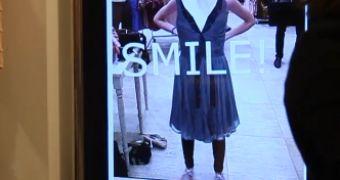Remember all those Xbox 360 users standing in line to get a new Kinect natural user interface sensor when it was launched last year?
Well, they were actually the first consumers to recognize the amazing potential of Kinect and act on it.
Last week, news emerged of a Kinect fitting room, designed by AR Door and on display in a Topshop store in Moscow, along with the video embedded at the bottom of this article.
Now, granted, the Kinect fitting room still needs some work before it will actually be capable of satisfying customers by mirroring to perfection the experience of a traditional fitting room.
But don’t believe for a second that this won’t happen. The technology is still in the very early stages in terms of where its potential will take it, but in this regard, the experiment does a wonderful job of offering a glimpse of the next generation NUI augmented environments that will be possible.
Just this weekend, in an unrelated piece, I explored the possibility of 3D NUI computing spaces, entire rooms transformed into computers.
And of course, I’m not the only one. Work is already being done, from producing concepts to building prototypes, to create rooms that are also computers.
It’s rather easily to see that the evolution of computing paradigms will not only catalyze the birth of new form factors, but also have computers integrated into mundane objects.
Mirrors, tables, walls, every surface really, can easily house a computer. NUIs will subsequently become essential to help users interact with their new 3D computing environments, especially since such interaction models have an immense advantage for users, literally coming naturally to them.
Great devices such as Kinect already prove that the future belongs to NUIs, there should be little doubt about this.

 14 DAY TRIAL //
14 DAY TRIAL //